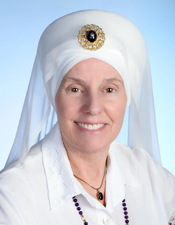The Siri Singh Sahib established the Ministry for our Dharma as a leadership body to serve the sangat and the world. On March 3, 1971, before the Akal Takhat, the Eternal Throne established by Guru Hargobind to serve as the Chief Seat of Religious Authority for Sikhs throughout the world, Yogi Harbhajan Singh was presented with a sword of honor. He was charged with the responsibility to return to the West and establish the Ministry of Sikh Dharma.*
According to our Sikh Dharma historian, SS Shanti Kaur Khalsa, the concept of a Sikh Ministry was first started by the Third Guru, Guru Amar Das ji, in the mid-1500s. It was near the end of Summer Solstice in June 1972 when the Siri Singh Sahib called many students to come take Sikh Minister vows.
From his wisdom and vision, the formation of Sikh Dharma’s Ministry (or the Sikh Dharma Brotherhood, as it was called in those early years) patterned itself on other religious organizations.
 “The Siri Singh Sahib wanted to ensure that Sikh Dharma would be treated like any other religion, both legally and administratively,” said MSS Shakti Parwha Kaur Khalsa.
“The Siri Singh Sahib wanted to ensure that Sikh Dharma would be treated like any other religion, both legally and administratively,” said MSS Shakti Parwha Kaur Khalsa.
“But he also made sure that we knew that the Ministry was to be an inverted pyramid, with the Siri Singh Sahib’s support at the very base, and the Mukhia Singh Sahibs and Mukhia Sardarni Sahibas on the next level of the pyramid, all serving the Dharma from the bottom up.”
The Siri Singh Sahib also made it clear that no Minister was to live off the sangat, as is the practice in other religions. Service marked the traits of a Minister then and now.
He dictated a minimum set of requirements for our Ministers to be current annually, including a signed letter (now addressed to the Secretary of Religion) requesting renewal of your Ministership from Baisakhi of that year to Baisakhi of the next year, as well as annual dues, two passport size pictures (now updated every six years), and a written exam (every other year).
He established these requirements to cover our Ministry legally and to have legal records of our Ministry. It seems to me that he also set these requirements because it is a conscious way for each Minister to renew their commitment to being a Minister and to reaffirm their duty and responsibilities of service in the domain of their Ministership each and every year.
Administrating the Ministry
The Office of the Secretary of Religion is responsible for the administration of the Ministry. You have heard me say often that is important to stay current with your Minister requirements so that you can answer the call, however that manifests.
I can remember SS Dr. Dyal Singh Khalsa telling me that he showed his Sikh Dharma International Minister’s card after the 9/11 tragedy in New York City and that, based on his Minister’s card, he was admitted to ground zero to serve in whatever ways he could. In this issue, we honor Singh Sahib Dyal Singh who has returned home to Akal Purkh by Guru’s Grace.
The time is now, and now is the time. Please be current. May God and Guru always bless you for your service as a Sikh Dharma Minister.
SS Dr. Sat-Kaur Khalsa, Secretary of Religion
*Excerpted from The Man Called The Siri Singh Sahib, 1979, Sikh Dharma, pp. 117-119
ABOUT THE SECRETARY OF RELIGION
 SS Dr. Sat Kaur Khalsa has served as Secretary of Religion since 1991 and was ordained as a Sikh Dharma Minister in 1975. As Secretary of Religion, Dr. Sat Kaur oversees and is ultimately responsible for the delivery of the functions of this Office. Dr. Sat Kaur is a long-time member of the International Khalsa Council and the Khalsa Council Executive Committee. Dr. Sat Kaur maintains a full-time psychotherapy private practice in Santa Monica, California and Santa Fe, New Mexico. She counsels individuals, couples, and families to support their personal and spiritual growth. She is a certified Kundalini Yoga teacher, facilitates White Tantric Yoga®, and is a published author.
SS Dr. Sat Kaur Khalsa has served as Secretary of Religion since 1991 and was ordained as a Sikh Dharma Minister in 1975. As Secretary of Religion, Dr. Sat Kaur oversees and is ultimately responsible for the delivery of the functions of this Office. Dr. Sat Kaur is a long-time member of the International Khalsa Council and the Khalsa Council Executive Committee. Dr. Sat Kaur maintains a full-time psychotherapy private practice in Santa Monica, California and Santa Fe, New Mexico. She counsels individuals, couples, and families to support their personal and spiritual growth. She is a certified Kundalini Yoga teacher, facilitates White Tantric Yoga®, and is a published author.


